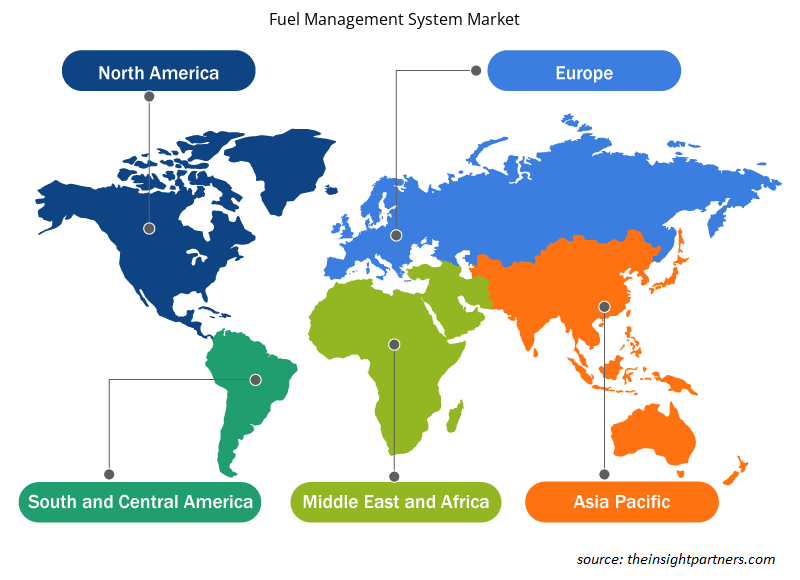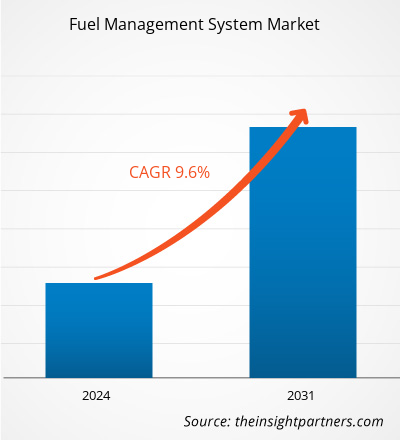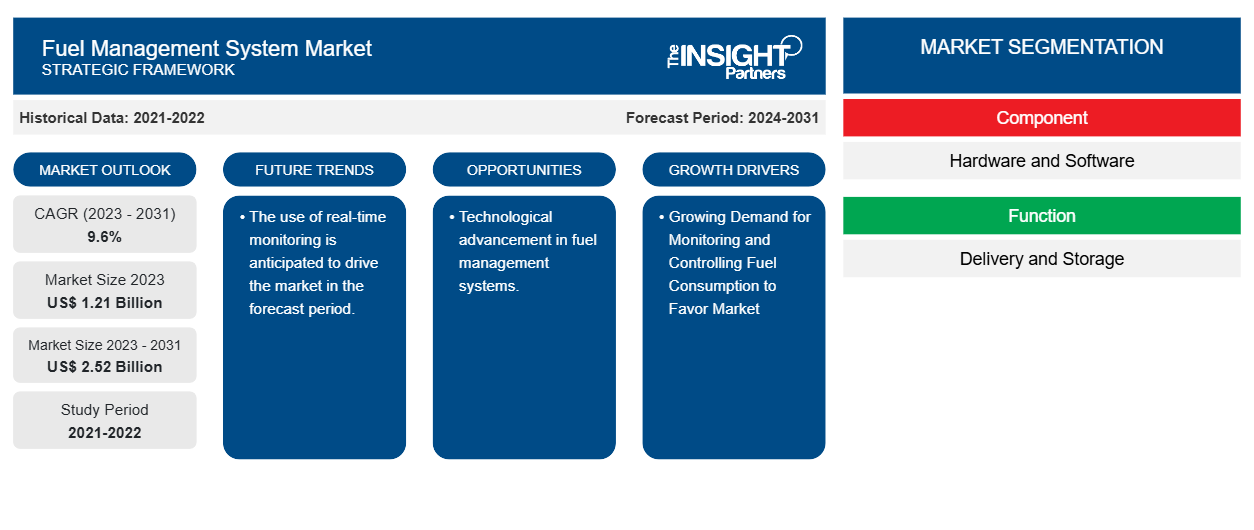Der Markt für Kraftstoffmanagementsysteme soll von 1,21 Milliarden US-Dollar im Jahr 2023 auf 2,52 Milliarden US-Dollar im Jahr 2031 anwachsen. Der Markt wird zwischen 2023 und 2031 voraussichtlich eine durchschnittliche jährliche Wachstumsrate von 9,8 % verzeichnen. Die steigende Nachfrage nach Überwachung und Kontrolle des Kraftstoffverbrauchs und die zunehmende Zahl von Kraftstoffdiebstählen dürften weiterhin die wichtigsten Trends auf dem Markt bleiben.CAGR of 9.8% during 2023–2031. Increasing demand for monitoring and controlling fuel consumption and increasing cases of fuel theft are likely to remain key trends in the market.
Kraftstoffmanagementsystem Marktanalyse
Die Nachfrage nach Kraftstoffmanagementsystemen dürfte mit dem steigenden Bedarf an besserem Kraftstoffmanagement zur Verbesserung der Produktivität und Effizienz in mehreren Branchen wachsen. Darüber hinaus hat das schnelle Wachstum von E-Commerce-Plattformen zur Verbesserung des Kundenerlebnisses die Versorgungs- und Logistikbranche dazu veranlasst, die IoT-Branchen zu stärken.
Marktübersicht für Kraftstoffmanagementsysteme
Ein Kraftstoffmanagementsystem ist eine Software- und Hardwaretechnologie, die zur Überwachung, Steuerung und Optimierung des Kraftstoffverbrauchs in verschiedenen Anwendungen, beispielsweise in der Transport-, Bau- und Energiebranche, eingesetzt wird. In Fahrzeugen können Kraftstoffmanagementsysteme dazu beitragen, dass Kraftstoff effizient genutzt wird, indem sie Kraftstoffverbrauch, Motorleistung und andere Faktoren überwachen. Dies kann dazu beitragen, die Kraftstoffkosten zu senken, die Betriebseffizienz zu steigern und die Emissionen zu senken.
Passen Sie diesen Bericht Ihren Anforderungen an
Sie erhalten kostenlose Anpassungen an jedem Bericht, einschließlich Teilen dieses Berichts oder einer Analyse auf Länderebene, eines Excel-Datenpakets sowie tolle Angebote und Rabatte für Start-ups und Universitäten.
-
Holen Sie sich die wichtigsten Markttrends aus diesem Bericht.Dieses KOSTENLOSE Beispiel umfasst eine Datenanalyse von Markttrends bis hin zu Schätzungen und Prognosen.
Markttreiber und Chancen für Kraftstoffmanagementsysteme
Steigende Nachfrage nach Überwachung und Kontrolle des Kraftstoffverbrauchs begünstigt den Markt
Die wachsende Nachfrage nach Überwachung und Kontrolle des Kraftstoffverbrauchs treibt den Markt für Kraftstoffmanagementsysteme an, da die Überwachung des Kraftstoffverbrauchs mehrere Vorteile mit sich bringt. Vorteile wie Kosteneinsparungen, Identifizierung von Ineffizienzen, Reduzierung von Emissionen usw. Darüber hinaus steigt auch die Nachfrage nach Echtzeitüberwachung des Kraftstoffverbrauchs. Dadurch können Unternehmen Kraftstoffverschwendung sofort erkennen und beheben, anstatt sie erst im Nachhinein zu verursachen. Dies kann Unternehmen dabei helfen, Kraftstoffverbrauch und -kosten in Echtzeit zu senken, was sich erheblich auf ihr Endergebnis auswirken kann. Angesichts der zahlreichen Vorteile der Überwachung und Kontrolle des Kraftstoffverbrauchs ist das Kraftstoffmanagementsystem gefragt.
Technologischer Fortschritt bei Kraftstoffmanagementsystemen.
Der technologische Fortschritt bei Kraftstoffmanagementsystemen bietet zahlreiche Chancen. Technologische Fortschritte wie IoT-Integration, prädiktive Analytik, Algorithmen für maschinelles Lernen, Blockchain für Transparenz, energieeffiziente Fahrzeuge usw. Diese Fortschritte können mehreren Branchen helfen, darunter Logistik und Transport, Fertigung und Lieferkette, Landwirtschaft, Bauwesen, Flottenmanagement und -dienstleistungen usw. Daher erhöht der technologische Fortschritt in verschiedenen Branchen die Nachfrage nach Kraftstoffmanagementsystemen.IoT integration, predictive analytics, machine learning algorithms, blockchain for transparency, energy-efficient
Segmentierungsanalyse des Marktberichts zum Kraftstoffmanagementsystem
Wichtige Segmente, die zur Ableitung der Marktanalyse für Kraftstoffmanagementsysteme beigetragen haben, sind Komponente, Funktion und Endbenutzer.
- Basierend auf den Komponenten ist der Markt für Kraftstoffmanagementsysteme in Hardware und Software unterteilt. Das Softwaresegment dürfte im Prognosezeitraum einen erheblichen Marktanteil halten.
- Basierend auf der Funktion ist der Markt für Kraftstoffmanagementsysteme in Lieferung und Lagerung unterteilt. Das Liefersegment wird im Prognosezeitraum voraussichtlich einen erheblichen Marktanteil halten.
- Nach Endverbraucher ist der Markt segmentiert in Bergbau, Bau und Häfen, Transport und Logistik, Öl und Gas und andere. Es wird erwartet, dass das Bergbausegment im Prognosezeitraum einen erheblichen Marktanteil halten wird.
Kraftstoffmanagementsystem Marktanteilsanalyse nach Geografie
Der geografische Umfang des Marktberichts zum Kraftstoffmanagementsystem ist hauptsächlich in fünf Regionen unterteilt: Nordamerika, Asien-Pazifik, Europa, Naher Osten und Afrika sowie Süd- und Mittelamerika.
Nordamerika dominiert den Markt für Kraftstoffmanagementsysteme. Die Einführung von Hochtechnologie in verschiedenen Branchen in Nordamerika hat das Wachstum des Marktes für Kraftstoffmanagementsysteme vorangetrieben. Faktoren wie die zunehmende Einführung digitaler Tools und hohe Technologieausgaben von Regierungsbehörden dürften das Wachstum des nordamerikanischen Marktes für Kraftstoffmanagementsysteme vorantreiben. Darüber hinaus zwingt eine starke Betonung von Forschung und Entwicklung in den entwickelten Volkswirtschaften der USA und Kanadas die nordamerikanischen Akteure dazu, technologisch fortschrittliche Lösungen auf den Markt zu bringen. Darüber hinaus gibt es in den USA viele Akteure auf dem Markt für Kraftstoffmanagementsysteme, die sich zunehmend auf die Entwicklung innovativer Lösungen konzentrieren. All diese Faktoren tragen zum Wachstum des Marktes für Kraftstoffmanagementsysteme in der Region bei.fuelled the growth of the fuel management system market. Factors such as increased adoption of digital tools and high technological spending by government agencies are expected to drive the North American fuel management system market growth. Moreover, a strong emphasis on research and development in the developed economies of the US and Canada is forcing the North American players to bring technologically advanced solutions into the market. In addition, the US has many fuel management system market players who have been increasingly focusing on developing innovative solutions. All these factors contribute to the region's growth of the fuel management system market.
Regionale Einblicke in den Markt für Kraftstoffmanagementsysteme
Die regionalen Trends und Faktoren, die den Markt für Kraftstoffmanagementsysteme im gesamten Prognosezeitraum beeinflussen, wurden von den Analysten von Insight Partners ausführlich erläutert. In diesem Abschnitt werden auch die Marktsegmente und die Geografie von Kraftstoffmanagementsystemen in Nordamerika, Europa, im asiatisch-pazifischen Raum, im Nahen Osten und Afrika sowie in Süd- und Mittelamerika erörtert.

- Erhalten Sie regionale Daten zum Kraftstoffmanagementsystem-Markt
Umfang des Marktberichts zum Kraftstoffmanagementsystem
| Berichtsattribut | Details |
|---|---|
| Marktgröße im Jahr 2023 | 1,21 Milliarden US-Dollar |
| Marktgröße bis 2031 | 2,52 Milliarden US-Dollar |
| Globale CAGR (2023 - 2031) | 9,6 % |
| Historische Daten | 2021-2022 |
| Prognosezeitraum | 2024–2031 |
| Abgedeckte Segmente |
Nach Komponente
|
| Abgedeckte Regionen und Länder |
Nordamerika
|
| Marktführer und wichtige Unternehmensprofile |
|
Marktteilnehmerdichte: Der Einfluss auf die Geschäftsdynamik
Der Markt für Kraftstoffmanagementsysteme wächst rasant, angetrieben durch die steigende Nachfrage der Endnutzer aufgrund von Faktoren wie sich entwickelnden Verbraucherpräferenzen, technologischen Fortschritten und einem größeren Bewusstsein für die Vorteile des Produkts. Mit steigender Nachfrage erweitern Unternehmen ihr Angebot, entwickeln Innovationen, um die Bedürfnisse der Verbraucher zu erfüllen, und nutzen neue Trends, was das Marktwachstum weiter ankurbelt.
Die Marktteilnehmerdichte bezieht sich auf die Verteilung der Firmen oder Unternehmen, die in einem bestimmten Markt oder einer bestimmten Branche tätig sind. Sie gibt an, wie viele Wettbewerber (Marktteilnehmer) in einem bestimmten Marktraum im Verhältnis zu seiner Größe oder seinem gesamten Marktwert präsent sind.
Die wichtigsten auf dem Markt für Kraftstoffmanagementsysteme tätigen Unternehmen sind:
- Chevin Flottenlösungen
- Elektro Frank
- Gilbarco Inc.
- : Multiforce Systems Corporation.
- Navig8
- Piusi SpA
Haftungsausschluss : Die oben aufgeführten Unternehmen sind nicht in einer bestimmten Reihenfolge aufgeführt.

- Überblick über die wichtigsten Akteure auf dem Markt für Kraftstoffmanagementsysteme
Neuigkeiten und aktuelle Entwicklungen zum Markt für Kraftstoffmanagementsysteme
Der Markt für Kraftstoffmanagementsysteme wird durch die Erhebung qualitativer und quantitativer Daten nach Primär- und Sekundärforschung bewertet, die wichtige Unternehmensveröffentlichungen, Verbandsdaten und Datenbanken umfasst. Nachfolgend sind einige der Entwicklungen auf dem Markt für Kraftstoffmanagementsysteme aufgeführt:
- Kongsberg Digital und Royston haben sich zusammengeschlossen, um ein elektronisches Kraftstoffmanagementsystem zu entwickeln. Die Partnerschaft wird es Schiffseignern ermöglichen, den Kraftstoffverbrauch zu optimieren, die Transparenz zu erhöhen und die Dekarbonisierung des Schiffsbetriebs zu fördern, indem sie Vessel Insight von Kongsberg Digital mit Enginei – dem elektronischen Kraftstoffmanagementsystem von Royston – kombinieren. (Quelle: Royston, Website der Pressefirma, Februar 2024)
- Airbus ist ein strategischer Partner von DG Fuels, LLC („DGF“) geworden, einem aufstrebenden Marktführer im Bereich nachhaltiger Flugkraftstoffe (SAF). Das Kraftstoffproduktionssystem von DGF basiert vollständig auf zellulosehaltigen Abfallprodukten, wie Holzabfällen aus der Holzindustrie, und erneuerbaren Energiequellen wie Wind- und Solarenergie. (Quelle: Airbus-Unternehmenswebsite, September 2023)
Marktbericht zum Kraftstoffmanagementsystem – Umfang und Ergebnisse
Der Bericht „Marktgröße und Prognose für Kraftstoffmanagementsysteme (2021–2031)“ bietet eine detaillierte Analyse des Marktes, die die folgenden Bereiche abdeckt:
- Marktgröße und Prognose für Kraftstoffmanagementsysteme auf globaler, regionaler und Länderebene für alle abgedeckten wichtigen Marktsegmente.
- Markttrends für Kraftstoffmanagementsysteme sowie Marktdynamik wie treibende Faktoren, Einschränkungen und wichtige Chancen.
- Detaillierte PEST/Porters Five Forces- und SWOT-Analyse
- Marktanalyse für Kraftstoffmanagementsysteme, die wichtige Markttrends, globale und regionale Rahmenbedingungen, wichtige Akteure, Vorschriften und aktuelle Marktentwicklungen abdeckt.
- Branchenlandschaft und Wettbewerbsanalyse, einschließlich Marktkonzentration, Heatmap-Analyse, prominenten Akteuren und aktuellen Entwicklungen für den Markt für Kraftstoffmanagementsysteme.
- Detaillierte Firmenprofile.
- Historische Analyse (2 Jahre), Basisjahr, Prognose (7 Jahre) mit CAGR
- PEST- und SWOT-Analyse
- Marktgröße Wert/Volumen – Global, Regional, Land
- Branchen- und Wettbewerbslandschaft
- Excel-Datensatz
Aktuelle Berichte
Verwandte Berichte
Erfahrungsberichte
Grund zum Kauf
- Fundierte Entscheidungsfindung
- Marktdynamik verstehen
- Wettbewerbsanalyse
- Kundeneinblicke
- Marktprognosen
- Risikominimierung
- Strategische Planung
- Investitionsbegründung
- Identifizierung neuer Märkte
- Verbesserung von Marketingstrategien
- Steigerung der Betriebseffizienz
- Anpassung an regulatorische Trends























 Kostenlose Probe anfordern für - Markt für Kraftstoffmanagementsysteme
Kostenlose Probe anfordern für - Markt für Kraftstoffmanagementsysteme